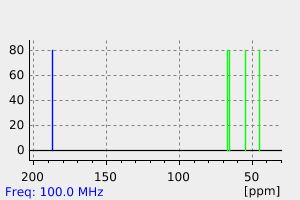4-thioformylmorpholine | 5780-30-3
中文名称
——
中文别名
——
英文名称
4-thioformylmorpholine
英文别名
morpholine-4-carbothialdehyde;N-morpholincarbothioaldehyde;4-Morpholincarbthialdehyd;4-(Thioformyl)morpholine;morpholinothioformamide;N-thioformylmorpholine
CAS
5780-30-3
化学式
C5H9NOS
mdl
——
分子量
131.199
InChiKey
OQAGLHPKFIVANA-UHFFFAOYSA-N
BEILSTEIN
——
EINECS
——
-
物化性质
-
计算性质
-
ADMET
-
安全信息
-
SDS
-
制备方法与用途
-
上下游信息
-
文献信息
-
表征谱图
-
同类化合物
-
相关功能分类
-
相关结构分类
物化性质
-
熔点:67.5-69 °C
-
沸点:106-110 °C(Press: 0.4 Torr)
-
密度:1.273±0.06 g/cm3(Predicted)
计算性质
-
辛醇/水分配系数(LogP):0
-
重原子数:8
-
可旋转键数:0
-
环数:1.0
-
sp3杂化的碳原子比例:0.8
-
拓扑面积:44.6
-
氢给体数:0
-
氢受体数:2
上下游信息
反应信息
-
作为反应物:描述:4-thioformylmorpholine 在 盐酸 作用下, 以40%的产率得到二苯基羟基膦烷硫酮参考文献:名称:Otten, P. A.; Gen, A. van der, Recueil des Travaux Chimiques des Pays-Bas, 1994, vol. 113, # 11, p. 499 - 506摘要:DOI:
-
作为产物:描述:参考文献:名称:Otten, P. A.; Gen, A. van der, Recueil des Travaux Chimiques des Pays-Bas, 1994, vol. 113, # 11, p. 499 - 506摘要:DOI:
文献信息
-
Evaluation of thioamides, thiolactams and thioureas as hydrogen sulfide (H2S) donors for lowering blood pressure作者:Ewelina Zaorska、Tomasz Hutsch、Marta Gawryś-Kopczyńska、Ryszard Ostaszewski、Marcin Ufnal、Dominik KoszelewskiDOI:10.1016/j.bioorg.2019.102941日期:2019.7Hydrogen sulfide (H2S) is a biologically important gaseous molecule that exhibits promising protective effects against a variety of pathological processes. For example, it was recognized as a blood pressure lowering agent. Aligned with the need for easily modifiable platforms for the H2S supply, we report here the preparation and the H2S release kinetics from a series of structurally diversified thioamides硫化氢(H2S)是生物学上重要的气态分子,对各种病理过程均显示出有希望的保护作用。例如,它被认为是降血压剂。为了满足对 供应的易于修改的平台的需求,我们在此报告了一系列结构多样化的硫代酰胺,硫代内酰胺和硫脲的制备和 释放动力学。基于五硫化二磷和Lawesson试剂的使用,使用了三种不同的硫磺化方法来制备目标硫代酰胺和硫代内酰胺。此外,在体内和体外研究中都评估了获得的 供体。测定了释放出的 的动力学参数,并使用两种不同的检测技术将其与NaHS和GYY4137进行了比较:荧光标记7-叠氮基-4-甲基-2H-铬-2--2-和5,5'-二硫代双(2-硝基苯甲酸),巯基探针,也称为Ellman试剂。我们已经证明,通过结构修饰可以控制从这些化合物释放 的量。最后,本研究显示了在麻醉大鼠中静脉注射发达供体的降压反应。
-
Novel Thiofomylation of Primary and Secondary Amines Using <i>N</i>-Aryl-1,2,3,4,5,7-Pentathiazocanes作者:Kazuaki Shimada、Hiroki Shibuya、Kenshiro Makino、Tatsuya Otsuka、Yuki Onuma、Shigenobu Aoyagi、Yuji TakikawaDOI:10.1080/10426501003773407日期:2010.5.27in the presence of primary and secondary amines afforded N-Alkyl or N,N-dialkylthioformamides 5, and similar heating of 1 in the absence of amines afforded an inseparable mixture of acyclic polysulfides 4 bearing a thioformanilide moiety on each terminal. Bisthioformanilides 4 were also converted into 5 by treating with these amines, and the thioformylation was assumed to proceed through a pathway
-
Three-Component Coupling Reactions of Thioformamides with Organolithium and Grignard Reagents Leading to Formation of Tertiary Amines and a Thiolating Agent作者:Toshiaki Murai、Fumio AsaiDOI:10.1021/ja068523f日期:2007.1.1three-component coupling reaction between thioformamides and organolithium and Grignard reagents was developed. The generality of the process has been demonstrated by using various combinations of reactants and reagents. Information about the mechanism of the reaction has come from 1H and 13C NMR spectroscopic detection of the key intermediate. The LiS group in the intermediates generated by addition
-
Direct Thionation and Selenation of Amides Using Elemental Sulfur and Selenium and Hydrochlorosilanes in the Presence of Amines作者:Fumitoshi Shibahara、Rie Sugiura、Toshiaki MuraiDOI:10.1021/ol9010882日期:2009.7.16Reactions of amides with elemental sulfur in the presence of hydrochlorosilanes and amines give the corresponding thioamides in good to high yields. The process takes place via reduction of elemental sulfur by the hydrochlorosilane in the presence of a suitable amine. The methodology can be applied to the selenation of amides by using elemental selenium. Thionation and selenation of an acetyl-protected
-
Synthesis of O-Ethyl Thioformate: A Useful Reagent for the Thioformylation of Amines作者:Christopher Borths、Johann Chan、Brenda Burke、Robert LarsenDOI:10.1055/s-0029-1218343日期:2009.12hydrogen sulfide gas using a Bronstead acid catalyst. The product can be isolated as a neat liquid in 83% overall yield. Both the crude and purified thiolate can be used to thioformylate a variety of amines in good to excellent yields.
表征谱图
-
氢谱1HNMR
-
质谱MS
-
碳谱13CNMR
-
红外IR
-
拉曼Raman
-
峰位数据
-
峰位匹配
-
表征信息
同类化合物
(4-甲基环戊-1-烯-1-基)(吗啉-4-基)甲酮
(2-肟基-氰基乙酸乙酯)-N,N-二甲基-吗啉基脲六氟磷酸酯
鲸蜡基乙基吗啉氮鎓乙基硫酸盐
马啉乙磺酸钾
预分散OTOS-80
顺式4-(氮杂环丁烷-3-基)-2,2-二甲基吗啉
顺式-N-亚硝基-2,6-二甲基吗啉
顺式-3,5-二甲基吗啉
顺-2,6-二甲基-4-(4-硝基苯基)吗啉
非屈酯
雷奈佐利二聚体
阿瑞杂质9
阿瑞杂质12
阿瑞吡坦磷的二卞酯
阿瑞吡坦杂质
阿瑞吡坦杂质
阿瑞吡坦EP杂质C
阿瑞吡坦
阿瑞吡坦
阿瑞匹坦非对映异构体2R3R1R
阿瑞匹坦杂质A异构体
阿瑞匹坦杂质54
阿瑞匹坦-M3代谢物
钾[2 - (吗啉- 4 -基)乙氧基]甲基三氟硼酸
酮康唑杂质
邻苯二甲酸单吗啉
调节安
试剂2-(4-Morpholino)ethyl2-bromoisobutyrate
茂硫磷
苯甲腈,2-(4-吗啉基)-5-[1,4,5,6-四氢-4-(羟甲基)-6-羰基-3-哒嗪基]-
苯甲曲秦
苯甲吗啉酮
苯基2-(2-苯基吗啉-4-基)乙基碳酸酯盐酸盐
苯二甲吗啉一氢酒石酸盐
苯二甲吗啉
苯乙酮 O-(吗啉基羰基甲基)肟
芬美曲秦
芬布酯盐酸盐
芬布酯
脾脏酪氨酸激酶(SYK)抑制剂
脱氯利伐沙班
脱氟雷奈佐利
羟基1-(3-氯苯基)-2-[(1,1-二甲基乙基)氨基]-1-丙酮盐酸盐
福沙匹坦苄酯
福沙匹坦杂质26
福沙匹坦N-苄基杂质
福曲他明
碘化N-甲基丙基吗啉
碘化N-甲基,乙基吗啉
硝酸吗啉







